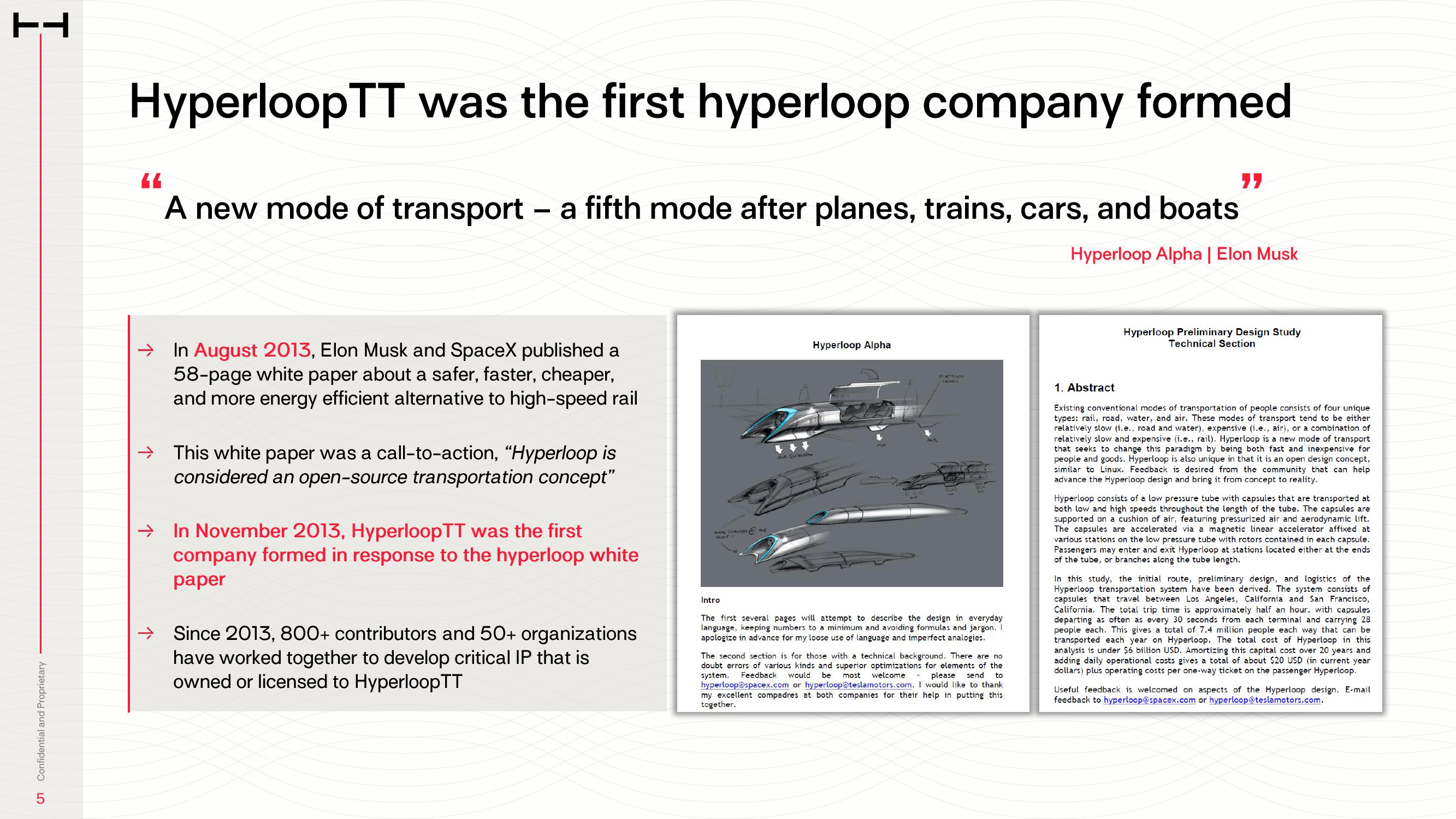HyperloopTT Investor Presentation Deck
H
Confidential and Proprietary
5
HyperloopTT was the first hyperloop company formed
44
A new mode of transport - a fifth mode after planes, trains, cars, and boats
Hyperloop Alpha | Elon Musk
In August 2013, Elon Musk and SpaceX published a
58-page white paper about a safer, faster, cheaper,
and more energy efficient alternative to high-speed rail
This white paper was a call-to-action, “Hyperloop is
considered an open-source transportation concept"
→ In November 2013, HyperloopTT was the first
company formed in response to the hyperloop white
paper
Since 2013, 800+ contributors and 50+ organizations
have worked together to develop critical IP that is
owned or licensed to HyperloopTT
THE PLANTED
Intro
+++
ARCUSHION
Hyperloop Alpha
Cha
PLATTORE
LEVEL
The first several pages will attempt to describe the design in everyday
language, keeping numbers to a minimum and avoiding formulas and jargon. I
apologize in advance for my loose use of language and imperfect analogies.
-
to
The second section is for those with a technical background. There are no
doubt errors of various kinds and superior optimizations for elements of the
system. Feedback would be most welcome please send
[email protected] or [email protected]. I would like to thank
my excellent compadres at both companies for their help in putting this
together.
77
Hyperloop Preliminary Design Study
Technical Section
1. Abstract
Existing conventional modes of transportation of people consists of four unique
types: rail, road, water, and air. These modes of transport tend to be either
relatively slow (i.e., road and water), expensive (i.e., air), or a combination of
relatively slow and expensive (i.e., rail). Hyperloop is a new mode of transport
that seeks to change this paradigm by being both fast and inexpensive for
people and goods. Hyperloop is also unique in that it is an open design concept,
similar to Linux. Feedback is desired from the community that can help
advance the Hyperloop design and bring it from concept to reality.
Hyperloop consists of a low pressure tube with capsules that are transported at
both low and high speeds throughout the length of the tube. The capsules are
supported on a cushion of air, featuring pressurized air and aerodynamic lift.
The capsules are accelerated via a magnetic linear accelerator affixed at
various stations on the low pressure tube with rotors contained in each capsule.
Passengers may enter and exit Hyperloop at stations located either at the ends
of the tube, or branches along the tube length.
In this study, the initial route, preliminary design, and logistics of the
Hyperloop transportation system have been derived. The system consists of
capsules that travel between Los Angeles, California and San Francisco,
California. The total trip time is approximately half an hour, with capsules
departing as often as every 30 seconds from each terminal and carrying 28
people each. This gives a total of 7.4 million people each way that can be
transported each year on Hyperloop. The total cost of Hyperloop in this
analysis is under $6 billion USD. Amortizing this capital cost over 20 years and
adding daily operational costs gives a total of about $20 USD (in current year
dollars) plus operating costs per one-way ticket on the passenger Hyperloop.
Useful feedback is welcomed on aspects of the Hyperloop design. E-mail
feedback to [email protected] or [email protected].View entire presentation